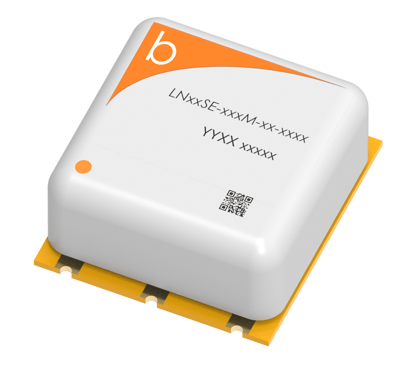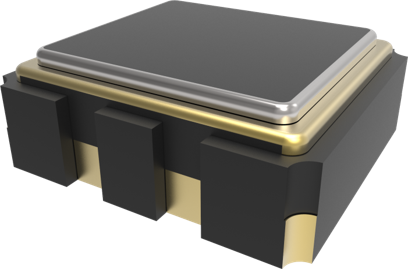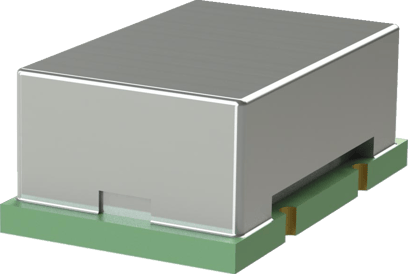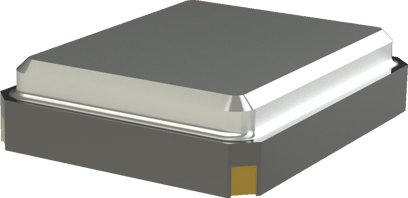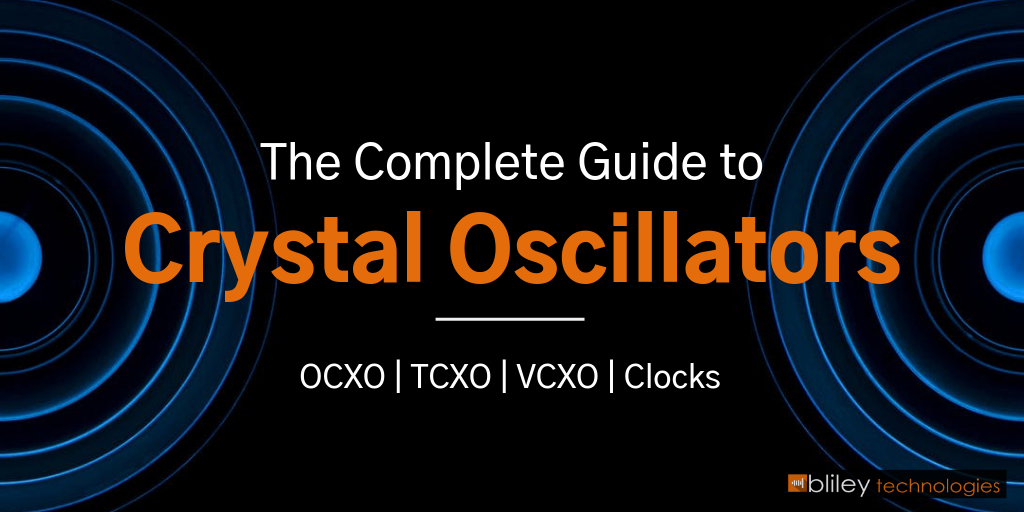
We'll be honest, crystal oscillators aren't the easiest topic to understand. That's mostly because there's a wide variety of crystal oscillator types that do different things, in different ways, for different purposes. This is largely due to their almost endless applications. From satellite communications in space, to military & defense, to telecom and more... there are so many different needs for crystal oscillators.
In this post, we'll cover the most common types of crystal oscillators, which include:
- Oven controlled crystal oscillators (OCXO)
- Temperature compensated oscillators (TCXO)
- Voltage controlled oscillators (VCXO)
- Clock oscillators (XO)
- And some other key types within these categories
I know it sounds like a lot to cover, but don't worry! We're about to make things a whole lot easier for you. By the end of this post, you'll learn the basic uses, advantages, and limitations of each crystal oscillator type.
Oven Controlled Crystal Oscillators (OCXO)
Typical Temperature Stability: ±1 x 10-7 to ±1 x 10-9
Typical aging rate: ±2 x 10-7/year to ±2 x 10-8/year
Typical Power Consumption: 1.5 Watts to 2.0 Watts in a steady state condition (at +25°C ambient temperature)
An oven controlled crystal oscillator (OCXO) is a crystal oscillator that is temperature controlled by a mini internal oven. This type of oscillator has a temperature controlling circuit to maintain a consistent temperature of the crystal and other key components.
OCXOs are typically used when temperature stabilities of ±1 x 10-8 or better are required. While this type of oscillator has a tenfold improvement over a TCXO for temperature vs. frequency stability, the OCXO tends to be higher in price and consumes more power.
Temperature Characteristics of OCXO Circuits
The key to an OCXO is to keep the crystal and some of the other oscillator components at one specific temperature while the outside ambient temperature changes. This can be compared to a house in the winter, where a thermostat located inside the house senses a temperature change and controls the furnace to maintain a desired temperature.
What is the desired temperature of operation? The temperature of operation is one of the crystal's turning points (refer to crystal section). At the turning point, the slope of the frequency versus temperature curve is zero. This means that even if the temperature varies up or down slightly, the frequency change is minimal.
Note that for an OCXO, the turning point temperature of a crystal must be higher than the upper limit of your temperature range. This is because you could not control a house's temperature at +25°C with a furnace if the outside temperature is +35°C. A general rule of thumb is that you will need the turning point of the crystal to be 10°C higher than the upper operating temperature of the OCXO oscillator circuit.
For an OCXO, the thermistor (we’ll chat more about this in the TCXO section) is equivalent to the thermostat in the house. It is used to sense the temperature of the crystal and crystal oscillator circuitry. The heat source can be either a power transistor or a power resistor. The last component required is a comparator circuit that is used to control the amount of power generated in the heat source.
The Comparator Circuit
The comparator circuit consists of an op-amp and other components (resistors and capacitors) configured as a high gain amplifier. The temperature of operation is called the “set point” and is adjusted by a selected value resistor chosen during the normal production process.
During normal operation, the thermistor senses an ambient temperature change by changing to a slightly different resistance value. The comparator circuit then adjusts the power generated to return the thermistor back to the original resistance value and the crystal and circuit temperature to the original set point temperature.
Sticking with the house comparison... OCXOs use insulation in a similar fashion to a house. Insulation is used to lessen the effects of ambient temperature changes and to reduce the amount of power required to maintain the set point temperature. The better the insulation used, the less power is required to stay at the set temperature point. More and more of today’s RF applications are requiring lower power input, so insulation plays a key role.
The temperature controller circuit of a typical OCXO will hold the set point temperature within ±1°C or less.
The Double Oven OCXO (DOCXO)
A double oven oscillator (DOCXO) might be required if tighter stabilities (±1 x 10-10 to ±5 x 10-11) are required. A DOCXO is made by putting an OCXO inside another oven package. This outer oven will buffer the OCXO from ambient changes and the combination of two temperature controllers can hold the set point temperature to within ±0.10°C.
Some of the biggest downfalls of using DOCXOs include
- They require a larger package size
- They consume more power
- They are typically more expensive
Typical power intake for a double oven oscillator at +25°C ambient is 3.0 Watts to 4.0 Watts in a steady state condition.
Because OCXOs have aging rates of 0.20 ppm/year to 2.0 x 10-8/year, there is a need to adjust the frequency at +25°C to offset aging effects. Most OCXOs have mechanical frequency adjustment similar to TCXO oscillators. The typical adjustment range is +2 ppm to ±0.20 ppm.
Types of Quartz Crystal Cuts in OCXOs
The type of crystal cut will also add to the stability of the oscillator. Some types of cuts have different slopes of frequency versus temperature at their turning points. The 2 most common types of cuts are AT and SC cuts.
For example, the SC cut crystal might have a slope of 5 x 10--9/°C for a +80°C turning point while an AT-type crystal might have a slope of 1 x 10-8/°C for an 80°C turning point. With the same temperature controller, the AT-type crystal will change frequency two times the amount of the SC-type crystal. Temperature stability and operating temperature range requirements dictate the type of crystal cut used.
Temperature Compensated Crystal Oscillators (TCXO)
Typical Temperature Stability: ±0.20 ppm to ±2.0 ppm
Typical aging rate: ±0.50 ppm/year to ±2 ppm/year
Temperature compensated crystal oscillators (TCXOs) act similarly to OCXOs in that they manage the temperature of the crystal oscillator circuit. But there are also many differences.
The basic building block for a TCXO is a VCXO with approximately ±50 ppm deviation range and a temperature sensitive network. This temperature sensitive network (temperature compensation circuit) applies a voltage to the varactor diode that corrects the frequency of the VCXO at any temperature within the operating temperature range.
Typical temperature stabilities achieved from TCXOs would be from ±0.20 ppm to ±2.0 ppm. From this we can see that a TCXO offers about a tenfold improvement in temperature stability over a clock oscillator.
Related: The TXCO Oscillator: 5 Elements of Temperature Compensated Oscillators
The TCXO Circuit
To create a temperature compensation circuit, you’ll need something to sense ambient temperature. A thermistor is the typical sensing device in most TCXOs. Thermistors are resistive devices whose resistance is dependent upon the ambient temperature.
There are two types of thermistors:
- Ones with a positive coefficient (their resistance goes up as temperature goes up)
- Ones with a negative coefficient (their resistance goes down as the temperature goes up)
Typical temperature compensation circuits combine thermistors and resistors into a voltage divider network to produce the required correction voltage at any temperature. This correction voltage is then applied to the varactor.
If the temperature-compensation circuit matched a crystal's temperature curve exactly, the oscillator's frequency would remain constant as the temperature changed. This is not obtainable in the real world because of the variability of crystals available and the thermistor coefficients available. Each crystal's temperature stability varies slightly, and the exact thermistor coefficients and values to produce a perfect network area not always available.
Related: Can a Crystal Oscillator Operate Outside of Its Specified Temperature Range?
Typically, given sets of thermistors are used for all TCXOs in a production lot. This will allow most TCXOs to be corrected to acceptable stability. If a tighter temperature stability is required, the thermistor can be adjusted during the production sequence, but the cost of the TCXO will increase because of longer test times.
The other major problem to overcome is the perturbations (deviations from curve fit data) in the crystal temperature stability. These deviations from the smooth temperature curve are difficult to compensate for, and if they are of a narrow duration, impossible to compensate for. If the temperature stability requirement for a TCXO is too tight, some crystals might have to be replaced and production testing started over. This will increase the cost of the TCXO.
Because TCXOs have aging rates of 0.50 ppm/year to 2.0 ppm/year, there is a need to adjust the frequency at +25°C to offset aging effects. Most TCXOs have mechanical frequency adjust similar to clock oscillators. The typical adjust range is ±5 ppm.
Related: Temperature Compensated Crystal Oscillators (TCXOs): Performance & Common Types
Voltage Controlled Crystal Oscillators (VCXO)
Typical deviation ranges: ±10 ppm to as much as ±2000 ppm.
Typical aging rate: ±1 ppm/year to ±5 ppm/year
A voltage controlled crystal oscillators (VCXO) is a crystal oscillator with a frequency that can be adjusted by an externally applied voltage. VCXOs have a wide variety of applications in frequency modulation (FM) and phase-locked-loop (PLL) systems.
The frequency of voltage controlled oscillators is maintained by a device known as a varactor diode. This device is essentially a voltage variable capacitor. The capacitance of a varactor diode is inversely proportional to the voltage applied.
To understand how a diode can be a voltage variable capacitor, first consider what is a capacitor. It’s made of two oppositely charged plates separated by a dielectric. The diode is nothing more than a P-N silicon junction. The facing edges of the two regions act as plates. Reversed-bias forces charges to move away from their normal regions and form a depletion layer. The greater the voltage, the wider the depletion layer. This increases the distance between the plates, which decreases the capacitance.
To get larger tuning ranges, some varactors have a hyper-abrupt junction. The doping in a hyper-abrupt varactor is denser near the junction, which causes the depletion layer to be narrower, and the capacitance to be larger. Therefore, changes in reverse voltage have greater effects on capacitance.
The transfer function (or slope polarity) for a VCXO is the direction of frequency change versus control voltage. This can either be positive (meaning a positive change in voltage will cause the frequency to go higher) or negative (meaning a negative change in voltage will cause the frequency to go higher). This parameter needs to be specified or some slope will be assumed by the manufacturer.
As a general rule of thumb, do not specify more deviation range than is necessary. That’s because a VCXO with more deviation will be less stable with temperature and time. As an example:
- The temperature stability of a ±25 ppm deviation VCXO might be ±10 ppm over 0°C to +50°C, with a yearly aging rate of ±1 ppm.
- The temperature stability of a ±1000 ppm deviation VCXO might be ±100 ppm over 0°C to +50°C, with a yearly aging rate of ±5 ppm.
Related: How Does a VCXO Work?
Quartz Crystals & Clock Oscillators (XO)
Typical aging rate: ±1 ppm/year to ±5 ppm/year
Typical calibration tolerance: For an AT crystal, it would be ±10 ppm
Typical Frequency Adjustment Range: ±10 ppm to ±20 ppm
The crystal controlled clock oscillator (XO) is a device that achieves its temperature stability from the quartz crystal's inherent temperature stability. This characteristic is typically specified in tens of parts per million (ppm). The initial accuracy at room temperature (+25°C) is dictated by the calibration of the crystal for the most part.
A frequency adjustment electronic circuit could be incorporated so that the nominal frequency at room temperature could be adjusted for aging. This frequency adjustment would be achieved by use of a trimmer capacitor and the typical adjustment range would be ±10 ppm to ±20 ppm. With this type of adjustment, the frequency at +25°C could be set to ±1 ppm typically.
Quartz Crystal Oscillators That Will Take You Further
Not to brag, but Bliley Technologies has been a worldwide leader in the design and manufacturing of high-performance crystal oscillators for over 90 years! (Ok... maybe we're bragging a bit.)
We brag for good reason though. Our precision oscillators have been taking our customers' latest innovations further than ever before. We're always pushing the limits on size, weight, power, and cost (SWaP-C) to allow our customers to reach new heights.
Consider browsing our high-performance oscillator offerings to see if Bliley can take you (and your application) further at a better price.
